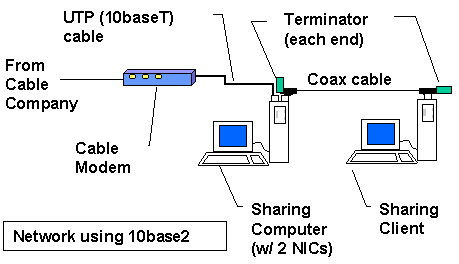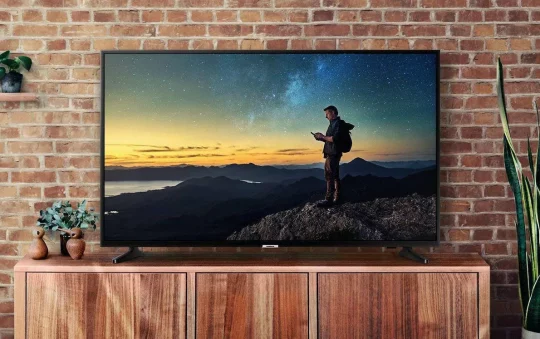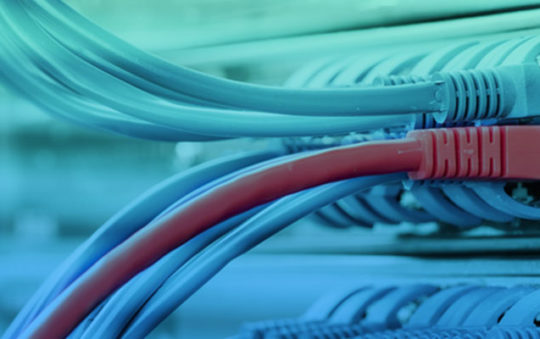Before your computers can share your Internet connection, they need to be able to share with each other! This means that you’ll have to connect them together to form a LAN. If you already have an Ethernet-based LAN, then you can go on to the next page. If you don’t, or aren’t sure, then read on.
What’s a LAN?
A LAN, or Local Area Network is a group of two or more computers, physically close together (usually in the same building), that are linked to each other. LANs can contain devices other than computers, for example, printers, print servers, storage devices, etc.
If you’re new to networking, there are many tutorials available on the web to get you started. See this page for links to them.
NOTE! Adding the second NIC is probably the most difficult part of getting your Internet connection shared. Many of the emails that I receive tell long tales of woe and struggle with this step.
Nevertheless, it’s important that you add that NIC! I’ve put together a page to help you through the process, so give it a look.
![]()
Choose Your Connection Method
You first need to determine the type of connection method to use for your network. During the past year or so, new options have appeared, so let’s summarize your choices:
Ethernet
Phone-line
Wireless
Power Line
Direct Cable Connection (only for two computers)
Let’s do Ethernet
Ethernet has been the most common LAN building method since it’s been around the longest, so the rest of this page will concentrate on the choices available in that method. The downside of using Ethernet is that you need to run special cabling in order to use it. If this will be a problem for you, then you should head on over to the Alternative Networking section and explore the other connection methods that are now available.
This page from this Linksys article gives a short summary of the two types of Ethernet cabling. Thin Ethernet (10base2) can run at a maximum of 10Mbps, while the proper grade of UTP cable can support up to 100Mbps operation. You’ll need a 100MBps hub and 100Mbps Network Interface Cards in order to take advantage of the higher speed, both of which cost slightly more than 10Mbps components. In most cases, a 10Mbps (10baseT) network will work just fine.
![]() Tip: Speeds up to 1Gbps (giga bits per second) are even possible over “CAT5” cable with the newer “gigabit over copper” Ethernet adapters!
Tip: Speeds up to 1Gbps (giga bits per second) are even possible over “CAT5” cable with the newer “gigabit over copper” Ethernet adapters!
Make sure you also take into account the maximum allowable cable lengths in deciding which type of cabling to use:
| Cable Type | Max. Length |
| 10Base2 (Thinnet) | 600ft |
| 10BaseT (UTP Category 5) | 328ft |
If you’d like more information on the Pros and Cons of the various kinds of Ethernet cabling, check the Linksys article.
Is “Thin Net” for you?
If you have only a few machines and want to spend the minimum amount of money, you can use 10base2 or “thinnet” or coaxial cabling to connect your computers as shown in the diagram below. This method is less expensive than using the 10baseT method (which I’ll talk about next), and contrary to some things you may read on the net, runs at the same speed as 10baseT.
Note that cable modems don’t support the 10base2 coaxial cable, but use 10baseT instead. So you’ll have to use UTP (Unshielded Twisted Pair) cable (see explanation below) to make the connection from the cable modem’s RJ45 connector to the RJ45 connector on the first NIC in the Proxy computer.
Here’s a cabling diagram of a simple network for sharing your cable modem, if you want to use 10base2 cabling. Only two computers are shown, but, of course, you can add more computers by removing a terminator, connecting another computer as shown below, and re-installing the terminator on the last computer in the chain.

10BaseT for Me!
If you have more than one sharing Client, or are planning to expand your network later, or have to run your cables in areas where they might be damaged or tampered with, then you should use 10baseT cabling to set up your network, as shown in the next diagram below.
Networking equipment manufacturers have made setting up a network easier by bundling NICs, cables, a hub and setup documentation into handy kits. This may be the way to go if you are setting up your first network, but please read this page on hubs before you buy one of these kits.
Note that you use a different kind of cable, called UTP (Unshielded Twisted Pair), for a 10baseT network. Although it may look like the cable that you use to connect your telephone to the wall, it’s not. So be sure to use the correct cable to build your network. This kind of network also doesn’t need terminators.
Don’t just connect everything to the 10baseT hub! Yes, I know all those jacks are inviting and it seems so simple, but unless your cable company has assigned you multiple IP numbers, it either won’t work, or at some point will stop working. For further explanation, see the Why Two NICs? and How a Hub Works pages.
Here’s a cabling diagram of a simple network for sharing your cable modem, if you want to use 10baseT cabling.
NOTE: If you follow the diagram below, do not connect any cables into the hub’s “uplink” port. That connector is used to connect one hub to another, in case you need more ports. (To “cascade” or “daisy chain” hubs, you would connect the “uplink” port on one hub to a normal port on another hub, using a regular UTP cable.)

Note that many more configurations of LANs are possible, including LANs that have both 10base2 and 10baseT sections (using hubs that suppport both standards, such as the Netgear EN104).
So you’ve selected your type of network wiring, and maybe even have things connected together. You now have to install and configure your LAN (Local Area Network) software.



